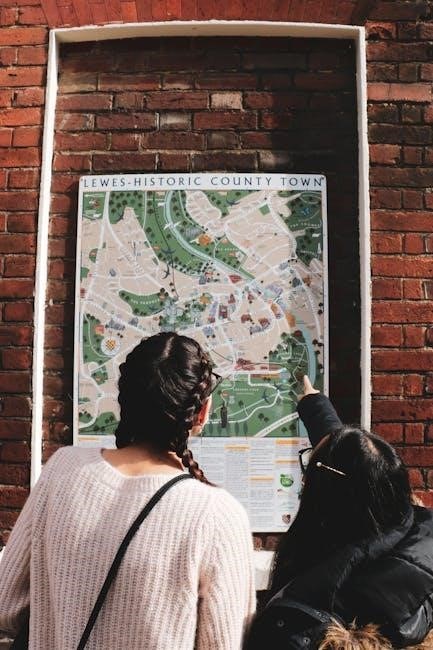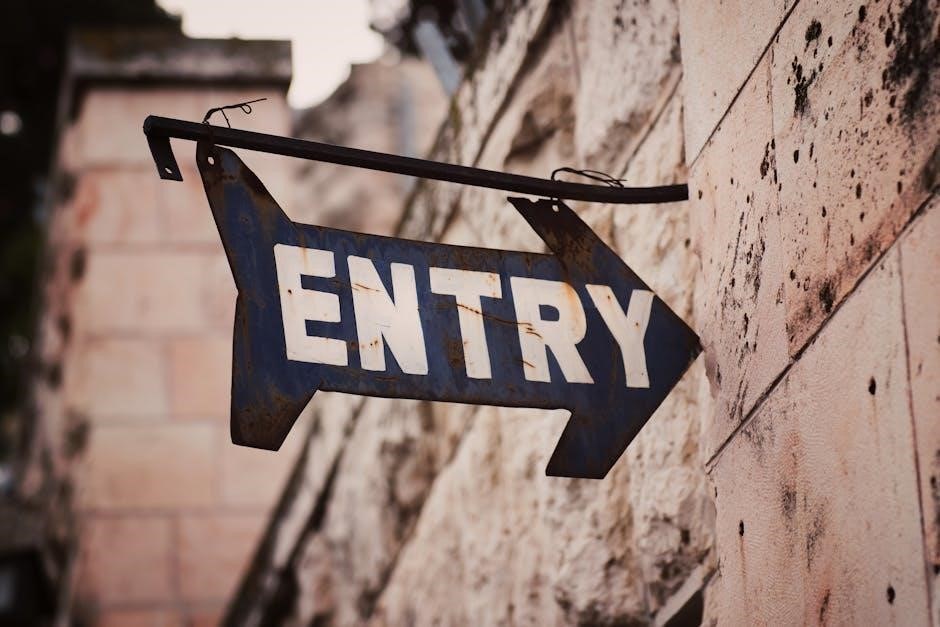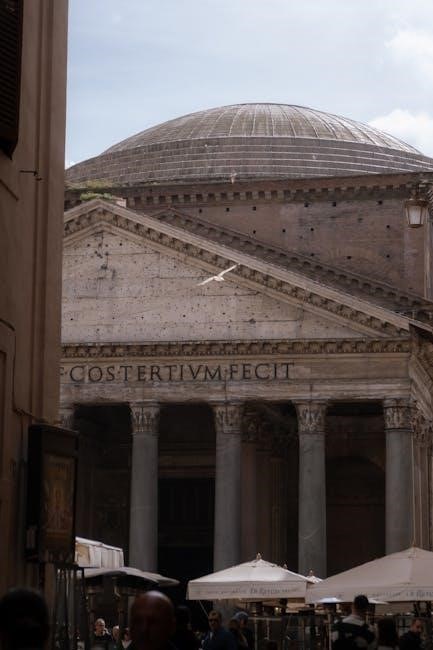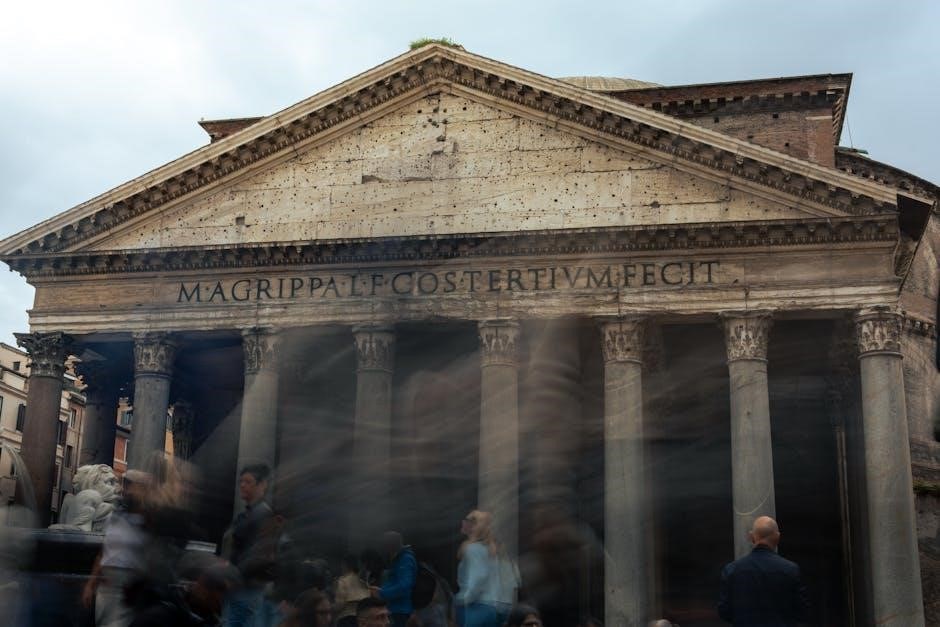
colosseum self guided tour
Explore the Colosseum at your own pace with a self-guided tour, offering flexibility and personalization. Discover ancient history, gladiator stories, and architectural marvels using audio guides or official apps. Tickets can be booked online through the official website, ensuring a seamless experience. This option allows visitors to immerse themselves in Rome’s iconic landmark without rushing, making it ideal for independent travelers seeking a deeper connection to history.
Why Choose a Self-Guided Tour?
A self-guided tour of the Colosseum offers unparalleled flexibility and personalization, allowing visitors to explore at their own pace. By avoiding rigid group schedules, you can linger at fascinating spots or skip crowded areas, creating a more enjoyable experience. This option is cost-effective, as it eliminates the higher fees of guided tours, with optional audio guides providing insightful commentary. Additionally, booking tickets through the official website ensures reliability and access to combined experiences, such as the Roman Forum and Palatine Hill. Ideal for independent travelers, a self-guided tour allows you to immerse yourself in history without rushing, making it a memorable and immersive way to discover the Colosseum.
Pros and Cons of a Self-Guided Tour
A self-guided tour of the Colosseum offers flexibility and cost savings, allowing visitors to explore at their own pace without adhering to a set schedule. This option is ideal for those who prefer independence and want to personalize their experience. However, it requires more planning and research, as there’s no guide to provide insights. Additionally, visitors might miss out on lesser-known details and historical context. While it’s budget-friendly, the lack of expert guidance can leave some feeling overwhelmed by the vast history of the site. Balancing these factors helps determine if a self-guided tour aligns with your preferences and goals for the visit.

Planning Your Visit
Plan your Colosseum visit by booking tickets in advance, checking opening hours, and preparing for security checks. Wear comfortable shoes and bring essentials like water and a hat.
Best Time to Visit the Colosseum
The best time to visit the Colosseum for a self-guided tour is during spring (April–June) or fall (September–October), when weather is mild and crowds are smaller. Avoid summer months due to extreme heat and peak tourism. Early mornings (8:30–10 AM) and late afternoons (3–5 PM) are ideal for avoiding long lines and enjoying a more relaxed experience. Weekdays are generally quieter than weekends. If visiting in winter (November–March), expect shorter opening hours but fewer tourists. Plan around holidays and special events, as they may attract larger crowds or closures. Check the official Colosseum website for up-to-date information before your visit.
How to Buy Tickets Online
Purchasing tickets online for a self-guided Colosseum tour is straightforward and highly recommended to save time. Visit the official Colosseum ticket website and select your preferred date and time. Choose the “self-guided” option to explore at your own pace. Complete the payment process, ensuring to provide required details like your name and ID number. Once booked, download your ticket or save it to your mobile device. Bring a valid ID and the confirmation email to gain entry. Online tickets often include access to the Roman Forum and Palatine Hill, offering great value. Be cautious of third-party sellers and always verify the website’s authenticity to avoid scams.

Understanding Skip-the-Line Access
Skip-the-line access is a convenient option for visitors to bypass long queues at the Colosseum. This privilege is often included with official tickets or combo passes, allowing direct entry to the venue. By avoiding wait times, you can make the most of your self-guided tour. Skip-the-line access typically applies to the main entrance but may not skip security checks, which are mandatory for all visitors. It’s a time-saving feature, especially during peak seasons when lines can be lengthy. Purchasing tickets with skip-the-line access in advance ensures a smoother and more efficient start to your exploration of this ancient wonder, enhancing your overall experience.

Understanding the Colosseum
The Colosseum, an iconic symbol of Rome, is one of history’s most impressive architectural achievements, showcasing ancient engineering prowess and historical grandeur as a venue for spectacles.
A Brief History of the Colosseum
Built in 70-80 AD under Emperor Vespasian, the Colosseum was Rome’s largest amphitheater, hosting gladiatorial contests, animal hunts, and public spectacles. It symbolized Roman power and engineering, accommodating up to 80,000 spectators. Over centuries, it fell into disrepair, especially after the Roman Empire’s decline, and was used as a quarry. Today, it stands as a testament to ancient Rome’s grandeur, attracting millions annually. Its history reflects Rome’s cultural and political evolution, making it a cornerstone of historical exploration for self-guided tours.
The Structure and Architecture
The Colosseum’s design is a marvel of ancient engineering, with an elliptical shape measuring 189 meters long and 156 meters wide. Built using travertine limestone and tuff stone, its facade features three levels of arches adorned with Doric, Ionic, and Corinthian columns. The hypogeum, an underground network of tunnels and chambers, supported the arena floor, enabling quick scene changes during events. The seating tiers were divided into sections for different social classes, offering excellent visibility for all spectators. This architectural masterpiece combined functionality with grandeur, making it one of Rome’s most iconic structures and a focal point for self-guided exploration.
Historical Significance
The Colosseum stands as an iconic symbol of Rome’s rich history and engineering prowess. Constructed in 80 AD, it was the largest amphitheater in the Roman Empire, hosting gladiatorial contests, animal hunts, and public spectacles. The venue symbolized the power and grandeur of the Roman Empire, showcasing its cultural and political dominance. Over 50,000 spectators gathered here, making it a hub for both entertainment and social interaction. Its historical significance extends beyond entertainment; it was also a site for religious ceremonies and public executions. Today, the Colosseum is a UNESCO World Heritage Site, attracting millions of visitors annually and serving as a testament to ancient Rome’s enduring legacy.
The Self-Guided Tour Experience
A self-guided tour offers a flexible and immersive journey through the Colosseum, allowing visitors to explore at their own pace and deeply connect with its history.
Starting Your Tour
Begin your self-guided tour by arriving early to avoid crowds and make the most of your visit. Ensure you have your tickets ready, either printed or on your mobile device, as this will speed up the entry process. The main entrance is located near the ticket booths, where staff will scan your ticket. Once inside, take a moment to pick up a map or download the official Colosseum app for guidance. Start by exploring the ground floor, where you can admire the ancient stone seating and get a sense of the arena’s grandeur. This is the perfect opportunity to set the tone for your journey through history.
Must-See Attractions Inside
During your self-guided tour, don’t miss the iconic Arena Floor, where gladiators once battled. Explore the Hypogeum, the underground tunnels that reveal the engineering behind the games. Climb to the upper tiers for breathtaking views of Rome and a glimpse into the seating arrangement of ancient spectators. Visit the Emperor’s Box, offering insights into the imperial family’s role in the Colosseum’s history. Take your time to admire the ancient stone seating and the remaining arches, which showcase the venue’s grandeur. These attractions provide a deeper connection to the Colosseum’s past, making your self-guided tour unforgettable.
Exploring the Arena Floor and Hypogeum
The Arena Floor, once the heart of gladiatorial battles, offers a thrilling glimpse into ancient Rome’s spectacle. Walking across the vast, open space evokes a sense of history and drama. Below lies the Hypogeum, a labyrinthine network of tunnels and chambers where gladiators and animals prepared for battles. These underground passages reveal intricate engineering, including remnants of pulleys and counterweights used to lift scenery. Visitors can explore these areas, imagining the roar of crowds and the intensity of the games. The Arena Floor and Hypogeum provide a unique perspective on the Colosseum’s function and the lives of those who fought within its walls.
Tips for Maximizing Your Visit
To make the most of your self-guided tour, wear comfortable shoes for extensive walking. Bring water and sunscreen, as the Arena Floor can be sunny. Arrive early to avoid crowds and enjoy a more immersive experience. Use an audio guide to deepen your understanding of historical details. Bring a guidebook or map to navigate the complex layout. Dress modestly and avoid large bags for smooth security checks. Take your time to absorb the history and architecture without rushing. Consider setting a pace to ensure you explore all key areas, including the Hypogeum and upper tiers. This approach ensures a memorable and enriching visit to the Colosseum.

Using Audio Guides
Audio guides provide detailed insights into the Colosseum’s history, architecture, and significance, available in multiple languages. They help visitors navigate and understand the complex layout, enhancing the self-guided experience.
How Audio Guides Work
Audio guides for the Colosseum are available as downloadable apps or physical devices. They provide step-by-step narration, synchronized with your location via GPS or QR codes. Each stop offers detailed insights into history, architecture, and legends. Many guides include multimedia, such as images and reconstructions, to enhance understanding. Visitors can pause, rewind, or skip sections, allowing a flexible pace. Guides are typically available in multiple languages, catering to international tourists. Some apps require pre-download, while others are accessible onsite. They are an excellent tool for deeper engagement without the constraint of a group tour, making the self-guided experience both informative and enjoyable.
Benefits of Using an Audio Guide
An audio guide enhances your Colosseum self-guided tour by providing in-depth insights and stories about its history, architecture, and significance. It allows you to explore at your own pace, pausing or replaying sections as needed. Audio guides often include expert narration, historical reenactments, and vivid descriptions, bringing the ancient site to life. They also offer flexibility, enabling you to focus on areas of personal interest. Additionally, audio guides are available in multiple languages, making the experience accessible to international visitors. This tool enriches your understanding and appreciation of the Colosseum, ensuring a more engaging and educational experience without the constraints of a group tour.
Downloading and Accessing Audio Guides
Downloading and accessing audio guides for your Colosseum self-guided tour is a straightforward process. Most official Colosseum apps or platforms offer downloadable audio guides that can be accessed via smartphones or tablets. Visitors can typically download the guide before arriving or connect to the venue’s Wi-Fi upon entry. Many guides are free with ticket purchases or available for a small fee. Ensure your device is fully charged, as you’ll likely use it throughout your visit. Some guides require a ticket barcode or booking confirmation to activate. Bring headphones to immerse yourself in the commentary without distractions. This convenient option ensures you can explore at your own pace while gaining valuable insights;

Comparing Self-Guided and Guided Tours
Comparing self-guided and guided tours highlights flexibility versus expert insights. Self-guided offers autonomy, while guided tours provide deeper historical context and personalized explanations, enhancing the overall experience.
Pros and Cons of Guided Tours
A guided tour offers expert insights and structured itineraries, providing a deeper understanding of the Colosseum’s history and significance. Guides often share hidden anecdotes and less-known facts, enriching the experience. However, guided tours can be more expensive and less flexible, as visitors must adhere to a set schedule. Additionally, larger groups may detract from the personal experience, and some tourists prefer exploring at their own pace. Despite these drawbacks, guided tours are ideal for history enthusiasts seeking detailed knowledge and a seamless, organized visit.
When to Choose a Guided Tour
A guided tour is ideal for those seeking in-depth historical insights and a structured experience. It’s perfect for first-time visitors unfamiliar with the Colosseum’s history or for families with children, as guides can engage younger audiences. History enthusiasts will appreciate the detailed commentary, while travelers with limited time benefit from the efficient, organized itinerary. Additionally, guided tours are recommended for visitors interested in accessing restricted areas or learning about lesser-known facts. They also offer the convenience of having an expert handle logistics and answer questions in real time, enhancing the overall experience and ensuring a memorable visit.
Cost Comparison
A self-guided tour of the Colosseum is generally more budget-friendly compared to guided tours. Basic self-guided tickets start around €12-18, while audio guides may add an extra €5-7. Guided tours, however, typically range from €25-40 per person, depending on the tour’s length and inclusions. Skip-the-line access often comes standard with guided tours, saving time. For families or groups, guided tours can be cost-effective if split among participants. Ultimately, the choice depends on your budget and preference for detailed insights versus exploring independently. Both options offer great value, but guided tours provide added convenience and expert knowledge for a higher price.

Additional Attractions
Explore beyond the Colosseum with visits to the Roman Forum and Palatine Hill. Discover nearby landmarks like the Arch of Constantine and Piazza Venezia, enriching your experience.
Exploring the Roman Forum
The Roman Forum, nestled between the Colosseum and Palatine Hill, is a sprawling archaeological site filled with ancient ruins. Once the heart of Rome, it features iconic landmarks like the Temple of Julius Caesar, Arch of Titus, and Basilica of Maxentius. Visitors can wander through the remains of basilicas, temples, and markets, gaining insight into Roman politics, religion, and daily life. The Forum Romanum offers a glimpse into Rome’s imperial past, with its well-preserved structures and historical significance. Exploring the site is a must for history enthusiasts, complementing the Colosseum experience with a deeper understanding of ancient Rome’s cultural and historical landscape.
Visiting Palatine Hill
Palatine Hill, one of Rome’s seven hills, is steeped in history and offers breathtaking views of the city. As the legendary birthplace of Rome, it features ancient ruins, including the remains of Emperor Augustus’s house and the Palatine Museum, which houses artifacts from the hill’s excavations. Visitors can explore the Farnese Gardens, a serene oasis with panoramic views. The hill’s proximity to the Roman Forum and Colosseum makes it a natural addition to a self-guided tour. Walking through the archaeological site provides a unique perspective on Rome’s origins and evolution, making Palatine Hill a must-visit for history enthusiasts.
Combining Attractions
Combining attractions like the Colosseum, Roman Forum, and Palatine Hill into one day maximizes your self-guided tour experience. These sites are geographically close, making it easy to explore them in a single visit. Purchasing a combined ticket online often saves money and time, as it grants access to all three locations. Start with the Colosseum, then head to the Roman Forum, and finish on Palatine Hill for a seamless journey through ancient Rome. This approach provides a comprehensive understanding of the city’s history and landmarks, while also saving time on individual entries. It’s an efficient way to immerse yourself in Rome’s rich heritage.

Practical Tips
Wear comfortable shoes, bring water, and use a map or guide. Arrive early to avoid crowds and make the most of your self-guided experience.

General Tips for Visitors
Plan ahead and wear comfortable shoes, as you’ll be walking extensively. Bring water, sunscreen, and a hat for outdoor comfort. Use a map or guide to navigate the Colosseum’s vast spaces. Arrive early to avoid crowds and long queues. Respect the site’s historical significance by following rules and signs. Security checks are mandatory, so avoid bringing large bags or prohibited items. Stay hydrated, especially during summer, by bringing a reusable water bottle. Take breaks in shaded areas if needed; Familiarize yourself with emergency exits and facilities locations. Enjoy the experience responsibly, preserving this ancient wonder for future visitors.
Photography and Videography
Capturing memories at the Colosseum is essential, but be mindful of rules. Non-flash photography is allowed for personal use, but tripods and professional equipment may require permits. Drones are restricted inside the archaeological area. Take advantage of natural light for stunning shots, especially during the golden hours of early morning or late afternoon. Experiment with angles to highlight the ancient architecture. Respect restricted areas and avoid touching or climbing structures. Use selfie sticks cautiously to avoid damage. Consider downloading apps for editing or enhancing photos on-site. Remember to balance photography with immersive exploration for a fulfilling experience. Always follow staff instructions to preserve this historical site.
Accessibility

The Colosseum strives to be accessible to all visitors, including those with disabilities. The main entrance is equipped with ramps, and elevators provide access to the arena floor and upper levels. Wheelchairs are available for loan free of charge, though advance booking is recommended. The pathways are generally smooth, but some areas may have uneven surfaces due to the ancient structure. Visitors with mobility challenges should plan their route in advance and seek assistance from staff if needed. Guided tours for visitors with special needs are also available upon request. These accommodations ensure an inclusive experience for everyone exploring this historic wonder.
Final Thoughts
A self-guided tour of the Colosseum offers a flexible, immersive way to explore Rome’s iconic landmark. With its rich history and stunning architecture, it’s an unforgettable experience.
A self-guided tour of the Colosseum is an excellent choice for those who value flexibility and independence. It allows visitors to explore this ancient wonder at their own pace, soaking in the history and grandeur without rushed timelines. By taking advantage of audio guides and pre-planning, you can deepen your understanding of the site. The Colosseum’s significance as a symbol of Rome’s past makes it a must-visit attraction. Whether you’re a history enthusiast or a curious traveler, a self-guided tour offers a memorable experience. With proper preparation and an open mind, you’ll leave with a profound appreciation for this iconic landmark and its enduring legacy.